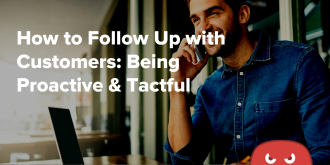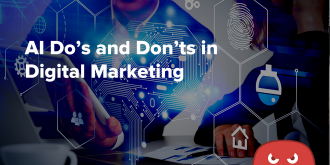Quick Links
Over 3.6 billion people used social media in 2020. That number’s projected to jump to 4.41 billion by 2025.
With those numbers, it’s clear most of your customers are there — and chances are, some are even talking about your brand, products, and services.
That makes social media more than a marketing channel. Implementing a social listening strategy can help you see what your customers think of your brand and devise ways to improve your reputation.
Below, we’ll explain social media listening, discuss its benefits, and cover different use cases. Then, we’ll break down exactly how you can create your own social media listening strategy.
What Is Social Media Listening?
Social media listening involves looking through social media platforms to discover feedback, conversations, and mentions relevant to your brand and industry. Then, you study that information and find ways to use it for growth and marketing opportunities.
Engaging in social listening helps you see what customers really think about you outside of surveys.
For instance, you might discover that customers are raving about your new product. You can analyze why they’re raving about your product — perhaps a specific feature — and use that to adjust your marketing campaigns in the future.
Or maybe you’ll notice that your customers are complaining about a specific issue. Then, you can take swift action to rectify the source of their dissatisfaction.
Social Listening vs. Social Monitoring
Social media listening and monitoring have a lot of overlap, and many marketers use the terms interchangeably. Social media monitoring is basically the first half of social listening — it’s a bit narrower in focus.
Social monitoring involves tracking mentions, replies, and interactions with your brand, then engaging with those users to build connections.
Social listening zooms out from these interactions. Instead of focusing on individual users, it tries to extrapolate insights from all these interactions to spot broad trends surrounding discussions about your brand and offers.
With social listening, you can go beyond simply replying to people — you can ideate brand new marketing messaging, generate product ideas, improve your branding, identify influence or brand partnership opportunities, and more.
Why Is Social Listening So Helpful?
In 2020, 22% of marketers named social listening as their number one tactic — ahead of everything else, including direct messaging, hashtags, user-generated content, and live video.
That’s because implementing social media listening into your marketing offers plenty of benefits, such as the following:
Helps You Understand Your Customer Better
Social media offers users the chance to air out their problems and relatively honest opinions about brands — especially if they don’t tag those brands. Plus, their bios help you see what kind of person they are and how they think of themselves.
All of this information is helpful for marketing purposes. You can connect better with your target audience and shape your brand voice.
Offers Competitor Intelligence
Your customers aren’t the only ones you can listen to with social listening tools. You can also “spy” on your competitors’ accounts and strategies.
You can study their brand voice, how they interact with customers, and even their user replies.
This can help you see what types of social media marketing and communications tactics are working well for other businesses in your industry. And it can also help you discover pitfalls to avoid.
Lets You Track Brand Growth
As your brand grows, more people will interact with you on social media. You’ll see more mentions and tags.
If you use custom hashtags, they can also give you a good idea of brand growth. You can peek at how many people are using your hashtags and what their posts look like.
With social listening tools, you can track and measure growth in all these areas over time.
Helps You Keep Up With Industry Trends
Social listening isn’t just about looking for brand mentions — it also involves keeping an eye on discussions surrounding industry trends.
You can hop on relevant industry hashtags, check out the latest discussions, and see if you notice any patterns in user posts.
You can also lurk the profiles of other non-competitor organizations in your industry and see what they’re talking about.
Gives You Opportunities to Improve Brand Image
According to Edelman’s Trust Barometer Special Report, about 81% of customers stated they needed to trust a brand before buying from them.
Hearing what customers have to say and responding to them like a human — meaning not sounding “dry” or “corporate” — can go a long way.
Dealing with dissatisfied customers is a great example. Someone on social media might tweet about disappointing experiences with your brand.
A calculated but authentic response showing you truly care about fixing the issue can mitigate a potential PR firestorm. You might even win the customer back.
Since your responses are public, it can improve your brand image for other users, too.
Another example might involve frequenting industry hashtags and replying to users discussing specific topics or linking to relevant content to build your authority and brand image.
Helps You Find More Leads
Nearly 41% of consumers use social media to discover new products, services, and brands nowadays.
A social listening strategy can help you capture your slice of the pie by finding trends in customer discussions surrounding their problems and identifying solutions.
You can also see if they’re aware of your brand or not and craft your social media response accordingly.
But untapped leads aren’t your only potential targets. You can listen in on your competitors’ dissatisfied customers and devise the perfect plan to pull them over to your brand.
Then, your satisfied customers will spread the word on social media, attracting more prospects and leads to your brand.
Keeping up these activities can help you create consistent lead flow from your social channels.
Helps You Find User-Generated Content Opportunities
User-generated content is any content your customers make for you. In general, it refers to things like social media posts, forum posts, or even user-created guides and tutorials.
Customers tend to trust other customers over your brand — for example, 79% of consumers in 2020 trust online reviews as much as personal recommendations from friends and family.
So with that in mind, your social media listening can help you find UGC opportunities. For instance, you can hunt for positive posts or mentions and get the user’s permission to repurpose and feature them on your accounts.
Going further, you could hunt for and reach out to relevant influencers. Not a bad idea, considering the average return is $5.78 per $1 spent on influencer marketing.
Examples of Social Listening
So the benefits of social listening are clear, but what does it look like in action?
Check out these use cases to see how other brands have taken advantage of social media listening:
Building and Tracking Brand Health
One of the most prominent social listening use cases is building, maintaining, and monitoring your brand’s health.
Target offers a great example:
As you can see, Target wasn’t tagged in this user’s tweet. However, Target listens for these mentions using social listening tools. Because the user isn’t expecting a reply, they’re more likely to air their true feelings about the brand.
Moments like these can also often be great chances to capitalize and initiate some social media marketing magic.
Like in this case, the company spotted a positive non-tagged tweet. But Target goes further than just responding normally — they composed the perfect reply/quote tweet with some personality and humor.
When the Twitter user saw Target quote-tweeted them, it got their attention and boosted their relationship with the brand. It also made everyone else who follows Target relate with the brand a little bit more.
All in all, it’s a great way to boost your brand image.
Event Monitoring
If you’re hosting an event, whether physical or digital, creating a hashtag is a great idea. It gets people involved in the conversation and helps you easily track what people think of the event.
However, attendees may forget to use the hashtag or tag your account. But even if they do, they’re likely using other keywords that you can listen for.
This can actually be a great source of potential leads for your event and your brand in general.
For instance, one attendee might tag a friend or colleague in a post expressing positive sentiment about your events. That’s your chance to swoop into the conversation and reply.
This gives you a chance to build rapport with the attendee and even start a conversation with the person they’re tagging — and potentially secure another attendee or customer.
Resolving potential PR problems
Social media virality is a double-edged sword. You can reach billions of people all over the world, but an isolated negative incident can go viral overnight and cause nightmares for brands.
Proper social listening can minimize the damage and even turn the situation into something relatively positive.
Take the Red Cross, for example. In 2011, someone at the organization accidentally posted a tweet meant for their personal account: “Ryan found two more 4 bottle packs of Dogfish Head’s Midas Touch beer… when we drink we do it right #gettngslizzerd.”
The Red Cross discovered this and the subsequent responses quickly as people started tweeting about it. Instead of just deleting it, they went into PR mode, but with a sense of humor:
The Red Cross also published a piece about it on their blog. (If you don’t have a presentable blog to share with your audience, reach out to Hoth Blogger for high-quality content that helps establish your thought leadership.)
In the end, social listening and smart moves turned a potential crisis into a positive for The Red Cross.
Proactive Customer Service
With so many users and brands on social media today, many customers expect brands to respond quickly and helpfully on social media channels.
If you can respond fast to assistance requests, your customers will appreciate it.
Check out how Wix uses social listening to find customers who need immediate assistance:
The customer reached out asking for help picking a plan, so they’re ready to buy. Wix replied the same day with a non-robotic response, letting them know they can contact the billing team and work with them to pick the best web hosting plan.
Social Listening for Small Businesses vs. Big Corporations
Big businesses have the budgets to hire teams of social media specialists and invest in industry-leading social media tools.
Wendy’s is one of the most famous examples of effective social listening at the enterprise level. Their Twitter humor has been a big part of reestablishing Wendy’s as a robust brand. Just look at how they took a shot at a top competitor:
This example is genius. Wendy’s is dunking on a competitor while taking advantage of a popular meme about McDonald’s. The brand awareness generated by 287 thousand retweets is worth a lot of advertising dollars.
This interaction shows the value of listening in on your competitor accounts and highlighting posts that get a lot of engagement — whether positive or negative.
Social listening can be just as effective for a small business — it’s even a chance to outcompete bigger companies.
Your small business is a lot more nimble than the big brands. These companies have to go through months of meetings and approvals to make small changes. You, on the other hand, can pivot your marketing messaging, brand image, content, and more without much hassle or cost.
Plus, large companies lose customers all the time. Even a small percentage of this churn represents tons of potential prospects.
Since you’re smaller, it’s easier to come across as authentic. Giant brands sometimes botch the whole “sounding human” thing, which can backfire on their brand.
How to Implement Social Listening in Your Marketing
Social listening offers a wide variety of benefits, but only if you know how to do it the right way. To help you get started on the right foot, we’ve outlined the necessary steps to creating and maintaining an effective social media listening strategy below.
1. Know Your Customer Persona
Your customer personas are profiles based on demographics and other factors that represent your ideal customer. These people are more likely to engage with your brand since your products or services are designed to serve them.
In social listening, a persona helps you identify which social media users you should focus on, which hashtags to watch, and which conversations to listen in on.
You can make your customer personas by researching your customer in-depth and discovering the demographic and psychographic commonalities. For example, age, area, job position, favorite social media platform, hobbies, etc.
Then, once you implement your social listening strategy, you can use what you find to refine them later.
2. Define Your Social Media Listening Objective
In 2019 and 2020, the average Internet user spent nearly 2.5 hours per day on social media. That leads to a lot of interactions. You can’t track all this data, so you have to define what you’d like to accomplish with your social media listening efforts.
For instance, are you trying to improve an existing product’s brand image? If so, don’t pay too much attention to other things, such as what users are saying about your competition. Sure, you can note that stuff if you stumble across it, but keep your eyes on your main objective.
3. Understand and Prioritize Platforms
Each social media platform is different in terms of format, usage, user base, atmosphere, and many other factors. As a result, different platforms offer advantages depending on your social media listening objectives.
For example, LinkedIn is oriented towards career and business, creating a more professional atmosphere. Some people may have conversations about products or brands on LinkedIn, but the majority focus on career and recruiting-related topics.
Meanwhile, a platform like Instagram is geared towards personal matters — and, of course, is centered around sharing pictures and videos. The discussions here often involve consumers’ personal experiences with brands.
4. Find the Right Social Listening Tool
Social listening is much more than looking for tweets or Instagram pictures relevant to your brand. So it isn’t viable without a capable social media listening tool containing an array of features.
Here are some things to look for in a social media listening tool:
- Coverage: How many platforms does the tool “listen to?” Does it also expand to news and blog sites? More is usually better, as long as it can go deep on each platform.
- Sentiment analysis: Sentiment analysis breaks down your brand’s reputation by analyzing and showing trends in positive, negative, and neutral mentions. This is an advanced feature more important for larger companies and brands.
- Social media management: It’s not enough to simply monitor your social media. Being able to manage your accounts, plan responses, and schedule posts in advance from the same platform streamlines your efforts and saves time.
- Real-time notifications: Notifications are especially important for managing PR crises. If someone posts about their bad experience with your product, notifications tell you right away so you can leap into action.
- Industry: Some social tools may be built for specific industries. These may have niche-specific features you’ll find useful for your type of business.
- Multi-language support: If you sell in markets that speak other languages, having a tool that supports those languages is necessary to engage in proactive support.
Some of the leading social listening tools include:
- Buffer
- BuzzSumo
- Falcon.io
- Hootsuite
- TweetReach
- Plann
5. Select Keywords and Topics to Monitor
Time to research what topics and keywords to look for with your social listening tool.
A few are easy to identify. For instance, any mentions of your brand, content, and products or services should be on your list of topics.
Beyond that, you can use your social listening tool to find more topics you may not have thought of.
6. Devise a Strategy for Responding to Social Media Mentions
Brands like Wendy’s look like they’re just responding haphazardly to users, but they definitely spent time crafting their strategy.
You should do the same. Create guidelines for how you’ll respond to positive and negative social media mentions. Decide how you’ll respond to tagged and untagged mentions.
Additionally, think about how you’ll respond to social media discussions around competitors. How will you respond to positive and negative mentions of competitors? Will you jump in on untagged conversations about them? Will you respond directly to competitors, and what will that look like?
Lastly, how far back will you go looking for these mentions when you launch your social listening efforts?
All these factors are vital to consider when making your strategy.
7. Create Templates for Responding to Comments
Once you nail down your strategies for responding to mentions, you should get to work on some templates for both negative and positive interactions. Make sure these reflect your brand voice and sound human. Too robotic, and you’ll turn off customers.
By making these templates, you won’t have to write a response from scratch every time. You can fill in the relevant information — such as the user’s name and problems they’re having — then copy and paste it into your social media post.
As time goes on, you may be able to formulate templates for certain types of replies, too.
8. Record Content and Keywords With the Most Attention
Notice any patterns in the content, discussions, and keywords among your target users on social media? That’s marketing gold for you. Set up a shared spreadsheet in Google Sheets for your team to record this information.
For instance, do you see a lot of discussion or engagement around one of your product’s features? That gives you insight into what problems your customers have that your product solves and potential marketing angles.
Or perhaps you share content on social media regularly. If you notice that certain types of content routinely get more engagement than others — that’s worth noting.
9. Continue to Hone Your Social Listening and Feedback Processes
As you begin your social listening efforts, you’ll learn a lot about your brand and how to improve. But you’ll also discover that you can make improvements to your social listening process itself.
One example would be the way you respond to and handle comments. One type of response that you thought might work well could end up making a dissatisfied customer angrier. That response template might warrant another look.
Another example — maybe you stumble on a hashtag you didn’t know about before. That might make a good addition to your social listening strategy.
Listen to Your Customers on Social Media
Social media can be a great marketing channel, but it’s more than that. With a solid social listening strategy, you can use each social platform to deepen your understanding of your audience, learn how to adjust your marketing messaging, identify user-generated content opportunities, and even repair potential PR disasters.
Ready to start using social media to your advantage? Our LockMyBrand service could be right for you. Schedule a call with The HOTH today to learn more.
















